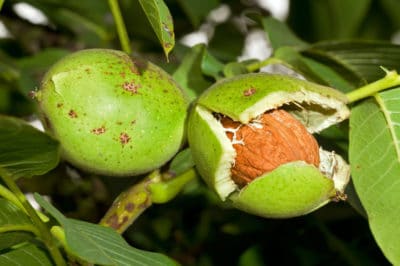Walnuts as Fruit?
For the sake of communicating, botanists and horticulturists divide vegetation into different categories. They categorize fruits and nuts differently. A fruit is what contains a plant’s seeds and according to the experts (who haggle over the specifics), walnuts count among the stone fruits known as “dry drupes.”
What’s a Dry Drupe?
A dry drupe has a fixed peel covering an inner shell that contains a single seed. Every walnut possesses a green outer hull, wrinkly shell and edible kernel. But anyone whose only encounters with walnuts are at the grocery store has never seen one with its outer hull intact.
The Boom-or-Bust Growth Cycle
Every walnut begins as a flower and every flower begins as a bud. But, because walnut buds don’t bloom until their second summer, many never reach the harvesting stage. Why? Both black and English walnut trees are known for fruiting heavily one year and being nearly barren the next. Why does this happen and what’s a walnut grower to do?
Alternate Bearing
Alternate (or biennial) bearing happens because, in heavy years, walnut trees divert most of their energy to their developing crop. Very little goes to buds destined to bloom the following summer. It’s called bud suppression, and it’s one way the trees have of compensating for poor growing conditions.
Managing Biennial Bearing
Breaking a walnut tree’s alternate bearing habit takes time, but it’s the best method of ensuring a respectable crop of nuts each year. Effective measures include:
- Thinning the fruit buds in the early spring of bumper-crop years. The reward is two years of average harvests instead of a boom-and-bust cycle.
- Thinning the developing walnuts at one-third of their mature size when bud removal isn’t possible. This improves the off-year harvest, but not as much as thinning the buds.
- Planting trees with a record of bearing evenly every year, such as the black walnut cultivars ‘Chandler’ and ‘Howard.’
- Planting zone-appropriate trees. Depending on cultivar, English and black walnuts are suitable for USDA zones 3 though 7 and 4 through 9, respectively.
Expert gardener’s tip: Early-spring fertilizer and supplemental water during drought also help break the cycle.
